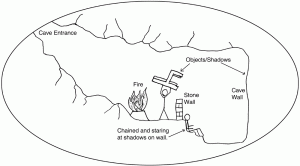 Book VII of Republic is perhaps the most important book of this work and certainly the most iconic one.
Book VII of Republic is perhaps the most important book of this work and certainly the most iconic one.
In this section Plato, or rather Socrates, presents us with an interesting and disturbing image: the allegory of the cave. This “S & M” image starts out with some men trapped in a cave with chains wrapped around their heads in some fashion that doesn’t allow them to move their heads or necks. They are always looking forward into a wall. Behind them there is a stone wall, behind the stone wall there is a fire. People walk between the fire and the wall carrying different objects. The wall serves as the wall which puppeteers use in their show.
The prisoners can only see shadows of the objects and people that pass between the fire and the wall. Since they have been chained up likes this their whole existence, this is all they know. The shadows are their reality, our reality. They are in the imagining stage of knowledge and knowing the forms.
One day, somebody decides to set one of the prisoners free. He does so and as he looks at the fire and the objects he is confused and his eyes (metaphor for the mind) are blinded by the light and by reality he accepts that this images are real. The shadows were mere reflections of the reality. He now is in the state of belief.
After this he walks out of the cave. His eyes (remember, metaphor) aren’t yet adjusted to reality and light so he can only look at reflections and shadows of things. After his eyes adjust he looks up and sees the sun, the source of all that he is able to see. The sun is the form of good. By exiting the cave his eyes where able to see reality and acquire knowledge of the forms.
The prisoner is the returned to the caves. His eyes have to adjust again to the shadows. This represents that once the forms have been known the philosopher must return to the shadows to rule over them and their inhabitants.
The philosopher is the one that knows the form of good, that is the key. But how does he achieve this? By studying mathematics and dialectic. This education allows him to transition from the visible realm, to the intelligible realm.
Children are to be chosen, according to their skills, to be raised as philosophers. They will endure physical training as well as education. The best will come to be chosen as philosophers the others as auxiliaries. They are to rule for the city and its people and according the form of good they have already grasped.
If all of this works perfectly the city will have people who have seen the form of good and can not see or do anything that disagrees with it. They are compelled to be good rulers.
This is a great summary of the book–thanks! You’ve got the main points here presented clearly. This is a pretty evocative image that some people think can still apply to us, today, living our regular lives. Is there some way in which we could be said to be staring at shadows on a wall, thinking they are real but missing the truth somehow?
On another note, could you please activate a plugin on your blog that allows those who make comments to get check a box to get an email if there are any replies to the comment? Go to the dashboard when you’re logged in, then find “plugins” on the left menu. Go to the one called “subscribe to comments” and click “activate.”
Thanks!